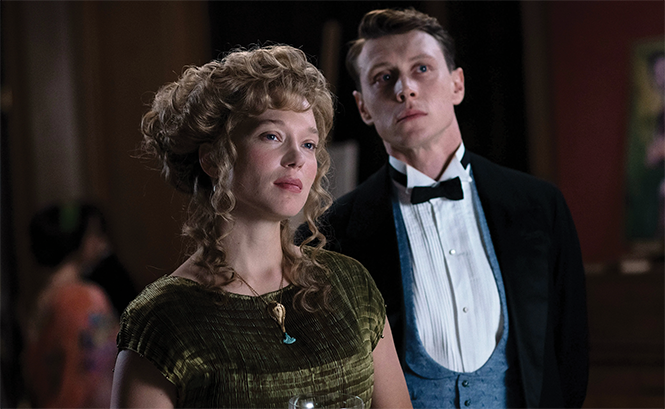Feature film review: THE BEAST
A filmmaker's compelling ideas get a bit tangled in references to his creative influences.
By Scott Renshaw @scottrenshawThere's an oft-repeated quote—generally attributed, perhaps apocryphally, to Pablo Picasso—to the effect that "good artists copy, but great artists steal." It's a pithy little line, albeit often a self-serving one, and not always particularly useful if you're trying to parse the fine distinction between "copy" and "steal." Every artist stands on the shoulders of giants, and comes to the act of creation having been inspired by those who came before. The trick, then, becomes threading the needle such that inspiration doesn't feel like duplication.
All of which brings us to the fascinating and frustrating case of Bertrand Bonello's The Beast, a genre-bending science-fiction/romance/drama/thriller built on complex ideas about isolation and anxiety. The only problems emerge when you keep spotting the scaffolding of other stories on which Bonello and his co-screenwriters have built this work. It starts to feel like reading one of those books where half of every page is made up of footnotes.
Structurally, it's unquestionably compelling, winding its way through multiple timelines, and two people whose lives seem to keep intersecting across more than a century. In 1910 Paris, Gabrielle (Léa Seydoux) is a married pianist who finds herself drawn to Louis (George MacKay), a man to whom she confided years earlier about the sense of impending doom that has haunted her life. In 2014, we find Gabrielle as a struggling model/actor in Los Angeles, with Louis as a troubled incel recording creepy videos about how women have ignored him. And in 2044 Paris, Gabrielle finds herself in a post-apocalyptic society ruled by artificial intelligence, engaging in a chemical past-life regression in an attempt to "purify her DNA" of events that might still be shaping her emotional responses.
The 1910-set section proves to be the most effective, in part because of its fidelity to the thematic ideas in its source material, the Henry James novella The Beast in the Jungle. Seydoux captures the paralyzing fear that keeps Gabrielle from actively pursuing love and happiness, and how her inability to open up to emotional possibility even hinders her work as a musician. Placing the story in the context of the Great Flood of 1910 in Paris adds a nice dose of real-world disaster to the proceedings, suggesting the kind of event that anxious people can point to as a reminder that terrible things do happen. And Bonello understands the context of the era perfectly, finding all of the longing involved at a time when holding someone's hand could feel like the most erotic, transgressive thing in the world.
Things start to get a little messier and less cohesive as The Beast leaves that story behind, and it becomes clearer that we're in the realm of something like Cloud Atlas in following characters across time. Bonello leans into not simply the connection between the Gabrielle and Louis characters across those eras, but individual moments that echo pointedly: an encounter with three women at a dance club; Gabrielle's conversations with a psychic (Elina Löwensohn); the presence of an ominous pigeon. What begins as a suggestion that unhealed psychic wounds can continue to have ripple effects turns into more of a genre exercise in exploring Nietsche's theory of eternal recurrence.
It remains compelling to watch, however—and might do so throughout, provided you're not distracted by Bonello nodding to his influences throughout the final hour. On a micro level, it might be something like evoking Michael Haneke's Funny Games in a scene where a home invasion includes what appears to be a rewinding of time. And on a much more noticeable level, it might be multiple moments that recall David Lynch work, from the use of a plaintive Roy Orbison ballad á la Blue Velvet to the shriek of realization at the climax of Twin Peaks: The Return.
Bonello clearly has his own sense of style and auteur fingerprints, even if it's something as fundamental as the interest in sprawling commentary about societal pressures, which was also evident in his 2016 feature Nocturama. Maybe he just thought it would be cool to wrap those ideas in a package that paid homage to other modern genre masters. He just needed to be a touch more subtle about it. Great artists steal, but maybe keep it hidden in your coat on the way out the door so the guard doesn't catch you.
More by Scott Renshaw
-
Film Reviews: New Releases for April 26
Challengers, Boy Kills World, Humane, Alien 45th anniversary
- Apr 25, 2024
-
CHALLENGERS feature movie review
Zendaya centers a romantic triangle with a unique relationship spin
- Apr 24, 2024
-
Film Reviews: New Releases for April 19
The Ministry of Ungentlemanly Warfare, Abigail, The Beast, Hard Miles, Sasquatch Sunset and more
- Apr 19, 2024
- More »




